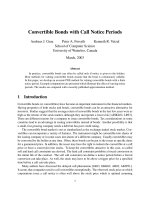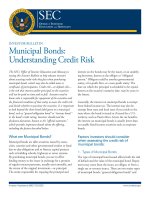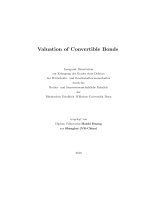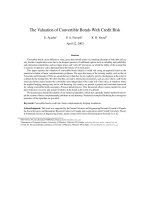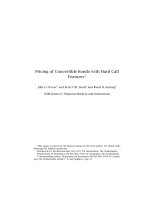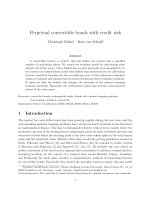Pricing of convertible bonds with credit risk and stochastic interest rate
Bạn đang xem bản rút gọn của tài liệu. Xem và tải ngay bản đầy đủ của tài liệu tại đây (612.4 KB, 103 trang )
NATIONAL UNIVERSITY OF SINGAPORE
DEPARTMENT OF MATHEMATICS
AN ACADEMIC EXERCISE PRESENTED IN PARTIAL FULFILLMENT
FOR THE DEGREE OF
MASTER OF SCIENCE IN FINANCIAL MATHEMATICS
OU GUOQING
HT091241U
August, 2010
PRICING OF CONVERTIBLE BONDS WITH CREDIT
RISK AND STOCHASTIC INTEREST RATE
SUPERVISOR: PROF TAN HWEE HUAT, PROF DAI
MIN
Pricing of convertible bond with credit risk and stochastic interest rate
2
Acknowledgement
I sincerely thank all those who have helped me in one way or another in this project.
I would like to take this opportunity to thank Professor Dai Min and Professor Tan
Hwee Huat for their guidance and assistance throughout the realization of the thesis,
despite their tight schedule in teaching, research and supervision of students.
Furthermore, I appreciate all professors in National University of Singapore who
imparted the essential foundations in stochastic calculus, computational mathematics
for tackling this project, such as Dr. Xia Jianming, Prof Bao Weizhu and Prof Liu Jie.
My thanks also go to Zhang Bixuan who provided me the up-to-date market data,
enlightening advices in programming, and several other friends whose technical
advices help me overcome the major or minor problems encountered.
I am deeply grateful to my parents who have physically come to support me in
Singapore. Their encouragement has certainly motivated me at many difficult times
in the process of realizing this project.
Pricing of convertible bond with credit risk and stochastic interest rate
3
Abstract
The convertible bond is an interesting security with its hybrid nature from both debt
and equity. Complications in pricing convertible bonds arise due to additional
contractual features such as callability and puttability, soft call provision.
Since 1991, most practitioners have used the binomial tree models to evaluate
convertibles bonds. In this thesis, a partial differential equation is formulated from
the Two-Factor model, attempting a consistent treatment of equity, interest rate and
credit risk as well as the incorporation of the call and put provisions. I shall present a
general framework for valuing convertible bonds, with a Black-Scholes stock price,
and the Hull White model for the interest rate.
By no-arbitrage, the Hull-White model is calibrated to fit the initial term structure of
interest rates as well as the volatility surface of European swaptions, which are
readily quoted from the financial market. The closed form formula of the European
swaption under the Hull-White model is deduced. With the Levenberg-Marquardt
algorithm, I seek to find model parameters that lead to a least-square fit to its market
prices.
The approach for solving the PDE is based on the numerical solution of linear
complementarity problems brought up in E Ayache, P Forsyth, K Vertzal (2003) and
the penalty method. A convergence study is conducted in the report.
Pricing of convertible bond with credit risk and stochastic interest rate
4
I hope that this report will impart on the subject of convertible bond pricing,
calibration of Hull-White model and the structure of convertible bonds to students
and others readers interested in financial products pricing with PDE approach.
Keywords: convertible bonds, credit risk, stochastic interest rate, Hull-White model,
Two-Factor model, calibration, Levenberg-Marquardt algorithm, penalty method
Pricing of convertible bond with credit risk and stochastic interest rate
5
Content page
Acknowledgement........................................................................................................3
Abstract ........................................................................................................................4
Content page.................................................................................................................6
List of figures ...............................................................................................................9
List of tables ...............................................................................................................10
1
INTRODUCTION..............................................................................................11
1.1
2
Convertible Bonds ......................................................................................11
1.1.1
Hybrid nature of convertible bonds........................................................12
1.1.2
Callable and puttable features of convertible bonds...............................13
1.2
Literature Review .......................................................................................14
1.3
Outline of the Report ..................................................................................15
HULL AND WHITE MODEL IN BOND PRICING ........................................18
2.1
HJM Model.................................................................................................18
2.1.1
Definition and value of a zero coupon bond ..........................................18
2.1.2
Value of the short rate ............................................................................19
2.1.3
Link with the Hull and White model......................................................20
2.2
3
Rate Processes ............................................................................................21
2.2.1
Short rate and forward rate .....................................................................21
2.2.2
Beta.........................................................................................................22
2.2.3
Zero coupon bonds .................................................................................22
CALIBRATION OF THE HULL-WHITE MODEL .........................................25
3.1
Pricing European Swaptions .....................................................................25
3.1.1
Numeraire change...................................................................................25
3.1.2
The case of the Hull and White model ...................................................26
3.1.3
Value of a call on a zero coupon bond ...................................................27
3.1.4
Value of a swaption ................................................................................28
3.2
General Mechanism of Calibration ............................................................30
3.3
Levenberg Marquardt Minimization Algorithm.........................................33
Pricing of convertible bond with credit risk and stochastic interest rate
6
4
3.3.1
The Gauss Newton Algorithm................................................................34
3.3.2
The Gradient Descent .............................................................................35
3.3.3
The Levenberg Marquardt Algorithm ....................................................35
PRICING MODEL OF CONVERTIBLE BONDS ...........................................37
4.1
Convertible bonds with credit risk and stochastic interest rate: Two-Factor
model ....................................................................................................................37
4.1.1
Model structure.......................................................................................37
4.1.2
Modeling credit risk with a Poisson process ..........................................38
4.1.3
Setting upon default in the Two-Factor model.......................................39
4.2
5
PDE Formulation........................................................................................40
4.2.1
Delta Hedging.........................................................................................40
4.2.2
Terminal and boundary conditions.........................................................43
4.2.3
Coupon payments and interest accrual ...................................................44
4.2.4
Formulation as a linear complementarity problem.................................45
4.2.5
Recovery under the Two-Factor model..................................................47
IMPLEMENTATION ........................................................................................49
5.1
Treating the Swap Curve ............................................................................49
5.1.1
Interpolation of the rate curves...............................................................49
5.1.2
Cubic spline interpolation ......................................................................52
5.2
Discretization..............................................................................................54
5.2.1
Discretization of the PDE.......................................................................54
5.2.2
Discretization on the boundary...............................................................56
5.3
6
Two Methods for Solving the Linear Complementarity Problem..............59
5.3.1
Penalty Method.......................................................................................59
5.3.2
Direct method for reinforcing the constraints of the bond price ............61
NUMERICAL RESULTS ..................................................................................63
6.1
Results from Calibraion..............................................................................63
6.1.1
a, σ , MSE ..............................................................................................63
6.1.2
Implied volatility surface from a and σ ................................................64
6.1.3
Implied volatility smile from a and σ ...................................................66
6.2
6.2.1
Convertible Bond Price ..............................................................................68
Parameters and explanation for parameters chosen................................68
Pricing of convertible bond with credit risk and stochastic interest rate
7
7
6.2.2
Comparing the penalty method and the direct method...........................70
6.2.3
Convergence of the finite-difference scheme.........................................71
6.2.4
CB price and the initial stock price, spot rate.........................................73
6.2.5
Relationship with correlation coefficient, hazard rate and maturity ......76
6.2.6
With and without coupon payment ........................................................80
CONCLUSION ..................................................................................................81
7.1
Result Evaluation .......................................................................................81
7.2
Further Studies ...........................................................................................83
8
REFERENCES ...................................................................................................84
9
APPENDICES....................................................................................................87
9.1
Codes of the Numerical Implementation....................................................87
9.1.1
C++ code on calibration .........................................................................87
9.1.2
Matlab code on convertible bonds pricing .............................................87
9.1.3
<convbond_fi_sir.m> .............................................................................88
9.1.4
<convbond_fi_sir_penalty.m> ...............................................................91
9.1.5
<convbond_fi_sir_cpc.m>......................................................................94
9.2
C++ Programme Flow ................................................................................97
9.2.1
Main code ...............................................................................................97
9.2.2
Inside the class G1analytics, interpolation and LMnumerics: ...............98
9.3
Class Variables of C++ code ......................................................................99
9.4
Class Functions of C++ code....................................................................100
Pricing of convertible bond with credit risk and stochastic interest rate
8
List of figures
Figure 1
Payoff of a convertible bond with κ=1 as the conversion ratio .............13
Figure 2
Input yield curve on annual intervals for deducing the discount factors...
................................................................................................................51
Figure 3
Discount factors on monthly intervals....................................................52
Figure 4
Initial short forward rates at t=0 on monthly intervals .........................52
Figure 5
C++ calibration output window showing the a and σ and the mean-
square errors in swapiton price .........................................................................63
Figure 6
Graph of extrapolated volatility surface ................................................65
Figure 7
Input volatility surface for comparison ..................................................66
Figure 8
Volatility skew for 2y2y swaption based our input data and calibration
results ................................................................................................................68
Figure 9
CB price V(S,r,0), given initial stock price S and spot rate r.................73
Figure 10 Two dimensional graph of V(S,r,0) against S, with speciific r values ..74
Figure 11 Two dimensional graph of V(S,r,0) against r, with specific S values....75
Figure 12 Graph of V (80, 0.05, 0, ρ ) against ρ .....................................................79
Figure 13 Graph of V (80, 0.05, 0, p) against p.......................................................77
Figure 14 Graph of V (80, 0.05, 0, T ) against T.......................................................78
Pricing of convertible bond with credit risk and stochastic interest rate
9
List of tables
Table 1
The input volatility surface from real market quotations.......................31
Table 2
Weight table indicating the swaptions used for calibration...................32
Table 3
Implied swaption price from Black’s model with input volatilities in
Table 1 ................................................................................................................33
Table 4
Implied volatility surface with a and σ obtained from calibration.......64
Table 5
Error between the extrapolated volatility surface and the market data.64
Table 6
Implied volatility for various strikes......................................................67
Table 7
Data for numerical implementation ......................................................69
Table 8
Comparison of convertible bond prices from two methods....................71
Table 9
CB price at various mesh sizes and time step sizes, Ns=Nr...................72
Table 10
CB price at various mesh sizes and time step sizes, Nt=Ns=Nr ............72
Table 11
Convertible bond price without coupon and with semi-annual coupon
payment of $4, S0=80, Ns=Nr=20.....................................................................80
Pricing of convertible bond with credit risk and stochastic interest rate
10
1 INTRODUCTION
1.1 Convertible Bonds
The market for convertible bonds has expanded tremendously in the past 10 years. At
the beginning of the decade, just over $60 bn were outstanding in the US which is
considered highly liquid as compared to other domestic markets. In early 2002, there
were approximately $270bn convertibles outstanding in the global market, $500bn in
2003 (E Ayache, P. A. Forsyth, K.R. Vertzal 2004), $600bn in 2004 (Sungard report,
2004) and, by some estimations (V. Gushchin, E. Curien, 2007), reached $700bn in
2006 and exceeded $800bn in 2007. As convertible bonds become an increasingly
popular source of finance for firms, new contractual features of convertibles were
continually developed including different types of call clauses with or without a
hurdle, trigger prices and “soft call” feature, clauses which restrict the conversion
right of holders to contingent events (CoCo clause, conversion based on stock price,
CoCoCB clause, conversion based on trading price condition), mandatory clauses
(Arzac, 1997), “death spiral” convertible bonds (Hillion and Vermaelen, 2001),
option to change the conversion ratio (Hoogland, Neumann, Bloch 2001), perpetual
feature (Sirbu, Pikovsky, Shreve, 2002). The development and sophistication in the
contractual features resulted in increasing technical challenges of the bond valuation,
which have certainly aroused the research interests of academics and practitioners
alike.
Pricing of convertible bond with credit risk and stochastic interest rate
11
1.1.1 Hybrid nature of convertible bonds
Convertible bonds are financial products, typically having the feature that the holder
can convert into shares of common stock in the issuing company or cash of equal
value at an agreed-upon price. It carries additional value to the holder through the
conversion right provided for the upside potential, the issuer on the other hand
benefits from the reduced interest rate.
If the bond holder chooses to convert during the lifetime of the bond, the bond is
redeemed the holder receives some common shares from the issuer. As long as the
bond holder does not convert the bond, he receives a coupon periodically and is still
repaid his principal at maturity. If the convertible bond remains live till maturity, the
payoff at maturity is
CB = max( B, κ S ) = B + (κ S − B) + .
(1)
It becomes clear that convertible bonds are hybrid financial products with bond-like
and equity-like features (Shown in Figure 1). The underlying risks come from both
the stock price and interest rate variation. The hybrid nature has inspired some
models to consider the convertible bond value to be composed of a bond component
and an option on the stock.
Pricing of convertible bond with credit risk and stochastic interest rate
12
CB
CB= max (B, KS)
0
0
S
Figure 1
Payoff of a convertible bond with κ=1 as the conversion ratio
1.1.2 Callable and puttable features of convertible bonds
Among the wide variety of contractual features, this thesis focuses on the call and put
provision. A put provision allows the holder to return the convertible to the issuer in
exchange for a predetermined amount of cash at certain points in time, and hence
provides a downside protection in case of rising interest rates. This adds a further
layer of protection to the conversion right that bond hoders already dispose of.
When convertibles are callable, the issuer has the option to purchase back the bond at
a predetermined strike price which often changes during the lifetime of the bond.
However, the holder still has the priority to convert the bond when the call
announcement is made; hence the call provision is often used to force early
conversion of the bond. Early conversion of a convertible bond is not optimal for the
holder under certain conditions; hence this call provision reduces the value of the
convertible. It limits the investor's return if interest rates fall or the stock price rises.
Pricing of convertible bond with credit risk and stochastic interest rate
13
Often, convertible bonds are call-protected for some years and become callable only
after that.
1.2 Literature Review
Interest rate models can be divided into two categories: equilibrium models, starting
with assumptions about economic variables and no-arbitrage model, taking today’s
term structure as an input and hence avoiding arbitrage opportunities. The second
category is more popular for its empirical realism, i.e. being able to fit initial term
structure.
In the second category, we capture the term structure of interest rates in two
approaches. One approach is to model the evolution of either forward rates or
discount bond prices. This approach was initialized by Heath, Jarrow and Morton
(HJM, 1992). In the paper, they specify the behavior of instantaneous forward rates.
The method is both easily comprehensible and powerful, as it contains many other
term structure models as special cases. It exactly fits the initial term structure of
interest rates and is compatible with complex volatility structures. On top of that, it
can readily be extended to as many sources of risk as desired.
More recently the HJM model has been modified by Brace, Gatarek and Musiella
(1997), Jamshidian (1997), and Miltersen, Sandmann, and Sondermann (1997) to
apply to non-instantaneous forward rates. This modification is known as the Libor
Market Model (LMM). In one version, 3-month forward rates are modeled. This
allows the model to exactly replicate observed cap prices that depend on 3-month
forward rates. In another version forward swap rates are modeled. This allows the
Pricing of convertible bond with credit risk and stochastic interest rate
14
model to exactly replicate observed European swap option prices. The main
disadvantage of the HJM –LMM models is that they are difficult to implement by
any means other than Monte Carlo simulation. Consequently, such models are
computationally slow and difficult to use for American or Bermudan style options.
The other major approach of the second category is to describe the evolution of the
instantaneous rate of interest, the rate that applies over the next short interval of time.
Short rate models are often more difficult to understand than models of the forward
rate, but they are computationally fast and useful for valuing all types of interest-rate
derivatives. They are often implemented in the form of a recombining tree similar to
the stock price tree first developed by Cox, Ross, and Rubinstein (1979).
The Hull-White model has mean-reverting feature and extends on the models of
Vasicek and Cox-Ingersoll-Ross to be arbitrage free. It contains many popular term
structure models as special cases, such as the Ho-Lee model. By introducing a timedependent drift, the resulting term structure of the Hull and White model is
consistent with current market prices of bonds. The Hull-White model is also chosen
for scope of this thesis for its convenience in model calibration as compared to the
Cox, Ingersoll and Ross model.
1.3 Outline of the Report
The main aim of this project is to calibrate the Hull-White model with real market
data and to study the pricing of the convertible bond, with the occurrence of default
considered in the pricing model.
Pricing of convertible bond with credit risk and stochastic interest rate
15
Section 2, Hull-White model: This section first details the link between the Heath,
Jarrow and Morton model (HJM) and the Hull-White Model, then gives the
stochastic formulas for all the variables (short rate, forward rate, zero coupon).
Section 3, Calibration: Firstly a closed formula for swaptions is established, which is
very useful for the calibration procedure. The section then explains how to choose
a and σ so that the model swaption volatilities best fit the market volatilities, and
gives a short overview of the Levenberg Marquardt minimization algorithm which is
used to minimize the error function
Section 4, Pricing model of convertible bonds: This section introduces the TwoFactor model which captures the credit risk with a Poisson process and makes some
reasonable assumptions upon default, while incorporating an additional stochastic
process of short term interest rate in response to the long life-span feature of
convertible bonds. The complete PDE is formulated by delta hedging arguments for
subsequent numerical implementation.
In Section 5, Implementation: This section explains how the swap curve is
transformed into a discounting curve, using cubic spline interpolation and
bootstrapping, the discretization of the PDE with two state variables inside the
solution domain and on the boundary, and how the penalty method and the direct
method are applied to solve the linear complementarity problem.
In Section 6, Numerical results: This section present the numerical results obtained
from calibration and from solving the PDE in the Two-Factor model, under the
assumption of zero recovery rate and total default. I will also demonstrate the
Pricing of convertible bond with credit risk and stochastic interest rate
16
convergence in the numerical results as the mesh size and time step are reduced and
study the correlation between CB price and its various parameters.
In Section 7, Conclusion: This section evaluates the numerical results obtained and
discusses possible future extensions in the subject.
Pricing of convertible bond with credit risk and stochastic interest rate
17
2 HULL AND WHITE MODEL IN BOND PRICING
2.1 HJM Model
2.1.1 Definition and value of a zero coupon bond
HJM is a class of models containing all the models diffusing zero coupon bonds and
assuming the following dynamic under the risk neutral measure:
dB(t , T )
= rt dt + Γ(t , T )dWt
B(t , T )
(2)
where B (t , T ) is the value of a zero coupon bond, rt is the short rate, Γ(t , T ) is a
volatility function, and Wt is a Brownian motion. We can notice that as the price of a
zero coupon is known when t = T (and is worth 1), Γ(T , T ) = 0 .
The solution of the stochastic equation is:
t
t
⎤
⎡t
1
B (t , T ) = B(0, T ) exp ⎢ ∫ rs ds + ∫ Γ( s, T )dWs − ∫ Γ( s, T ) 2 ds ⎥
20
0
⎣0
⎦
(3)
Taking T = t in the previous equation and using B(t , t ) = 1 we get:
t
t
⎤
⎡t
1
1 = B (0, t ) exp ⎢ ∫ rs ds + ∫ Γ( s, t )dWs − ∫ Γ( s, t ) 2 ds ⎥
20
0
⎣0
⎦ (4)
Dividing (3) by (4), we can eliminate the short rate and we get:
B (t , T ) =
t
⎡t
⎤
B(0, T )
1
exp ⎢ ∫ [Γ( s, T ) − Γ( s, t )]dWs − ∫ Γ( s, T ) 2 − Γ( s, t ) 2 ds ⎥
B(0, t )
20
⎣0
⎦ (5)
[
]
Pricing of convertible bond with credit risk and stochastic interest rate
18
2.1.2 Value of the short rate
The forward continuous nominal rate between T and T + θ , fixed at t , is defined as
Rt (T ,θ ) such that:
exp(θRt (T ,θ )) =
1
Bt (T , T + θ )
(6)
where Bt (T , T + θ ) is the forward value of a zero coupon which satisfies, by absence
of arbitrage:
Bt (T , T + θ ) =
B(t , T + θ )
.
B(t , T )
(7)
This means that
1
1
Rt (T ,θ ) = − ln( Bt (T , T + θ )) = − [ln( B(t , T + θ )) − ln( B(t , T ))]
θ
θ
(8)
From the definition and the value of the zero coupon bond Eq. (5) calculated in the
previous section
t
Rt (T , θ ) = R0 (T , θ ) − ∫
Γ ( s, T + θ ) − Γ ( s , T )
θ
0
1 Γ ( s, T + θ ) 2 − Γ ( s, T ) 2
dWs + ∫
ds (9)
θ
20
t
The forward short rate f (t , T ) is defined as
f (t , T ) = limθ →0 Rt (T , θ ) .
(10)
We have :
t
t
0
0
f (t , T ) = f (0, T ) − ∫ γ ( s, T )dWs + ∫ γ ( s, T )Γ( s, T )ds , where γ ( s, T ) =
∂Γ( s, T )
(11)
∂T
In particular the instantaneous short rate rt = f (t , t ) satisfies the equation:
t
t
0
0
rt = f (0, t ) − ∫ γ ( s, t )dWs + ∫ γ ( s, t )Γ( s, t )ds
(12)
Pricing of convertible bond with credit risk and stochastic interest rate
19
2.1.3 Link with the Hull and White model
The Hull and White model assumes that, under the risk neutral measure, the short
rate follows the dynamic:
dr (t ) = (θ (t ) − ar (t ))dt + σ (t )dW (t )
(13)
where
a represents the speed of the mean reversion
σ (t ) represents the volatility of the process
θ (t ) represents the long-term rate or mean-reverting benchmark
If we take
γ ( s, t ) = −σ ( s ) exp(−a(t − s ))
(14)
Then
Γ( s, t ) = −σ ( s )
1 − exp(−a(t − s ))
a
(since Γ(t , t ) = 0 ). (15)
This means that the value of rt given by the HJM model satisfies:
t
t
1
rt = f (0, t ) + exp(− at ) ∫ σ ( s ) exp(as )dWs + exp(− at ) ∫ σ ( s ) 2 exp(as )ds
a
0
0
t
1
− exp(−2at ) ∫ σ ( s )2 exp(2as )ds
a
0
(16)
Differentiating this equation we get:
drt =
⎛t
⎞
∂f (0, t )
dt + σ (t )dWt − a exp(− at )⎜⎜ ∫ σ ( s ) exp(as)dWs ⎟⎟dt
∂t
⎝0
⎠
(17)
⎛t
⎞
⎛t
⎞
− exp(− at )⎜⎜ ∫ σ ( s ) 2 exp(as )ds ⎟⎟dt + 2 exp(−2at )⎜⎜ ∫ σ ( s ) 2 exp(2as )ds ⎟⎟dt
⎝0
⎠
⎝0
⎠
Equivalently,
Pricing of convertible bond with credit risk and stochastic interest rate
20
⎛t
⎞
∂f (0, t )
drt + art dt = af (0, t )dt +
dt + ⎜⎜ ∫ γ ( s, t ) 2 ds ⎟⎟dt + σ (t )dWt
∂t
⎝0
⎠
(18)
Therefore the HJM model with the above choice for γ ( s, t ) is equivalent to the Hull
and White model, provided:
θ (t ) = af (0, t ) +
t
∂f (0, t )
+ ∫ γ ( s, t ) 2 ds
∂t
0
(19)
This condition needs to be satisfied to allow the Hull and White model to enter the
HJM framework and so to be arbitrage free.
2.2 Rate Processes
From now one we place ourselves in the case of a Hull and White model with a
constant volatility parameter, σ (t ) = σ . The diffusion equation becomes:
dr (t ) = (θ (t ) − ar (t ))dt + σdW (t )
2.2.1 Short rate and forward rate
The equations representing the short rate and the forward rate in the Hull and White
Model can be deduced from the equations presented above in the more generic case
of the HJM model. We only need to replace γ ( s, T ) and Γ( s, T ) with their values in
the case of the Hull and White model. We get the following equations:
rt = f (0, t ) +
f (t , T ) = f (0, T ) +
σ2
a2
σ2
2a 2
[1 − exp(−at )]
2
t
+ σ exp(−at ) ∫ exp(as )dWs
exp(− aT ) [ exp(at ) − 1] −
0
σ2
2a 2
(20)
exp(−2aT ) [ exp(2at ) − 1]
t
+ σ exp(− aT ) ∫ exp(as )dWs
0
(21)
Pricing of convertible bond with credit risk and stochastic interest rate
21
2.2.2 Beta
Beta represents the money market account, that is the amount of money that one
would get by placing 1 unit of currency at the risk neutral rate. More precisely:
⎛t
⎞
β (t ) = exp⎜⎜ ∫ rs ds ⎟⎟
⎝0
⎠ (22)
Using the value calculated for rt above, we can deduce the value of β (t ) . Indeed:
t
t
0
0
ln β (t ) = ∫ rs ds = ∫
⎛s
⎞
f (0, s )ds + ∫ 2 [1 − exp(−as )] ds + σ ∫ exp(−as)⎜⎜ ∫ exp(au )dWu ⎟⎟ds
0 2a
0
⎝0
⎠
t
σ2
2
t
(23)
Using the relation between the forward rate and the zero coupon bonds to simplify
the first term and Fubini’s theorem to exchange the integrals in the last term, we get:
σ2
σ2
σ2
t − 3 [1 − exp(− at ) ] + 3 [1 − exp(−2at ) ]
2a 2
a
4a
t
t
⎛
⎞
+ σ ∫ exp(au ) ⎜ ∫ exp(− as )ds ⎟dWu
0
⎝u
⎠
(24)
ln β (t ) = − ln( B(0, t )) +
β (t ) =
⎛ σ2
⎞
1
σ2
σ2
exp ⎜ 2 t − 3 [1 − exp(− at ) ] + 3 [1 − exp(−2at )] ⎟
4a
B(0, t )
a
⎝ 2a
⎠
t
⎛ σ
⎞
⎛σ ⎞
× exp ⎜ Wt ⎟ exp ⎜ − exp(− at ) ∫ exp(au )dWu ⎟
⎝a ⎠
0
⎝ a
⎠
(25)
2.2.3 Zero coupon bonds
The value of a Zero coupon bond at t can be calculated using the formula:
⎛ T
⎞
B(t , T ) = exp⎜⎜ − ∫ f (t , s )ds ⎟⎟
⎝ t
⎠ (26)
Pricing of convertible bond with credit risk and stochastic interest rate
22
The forward rate has already been calculated in the previous parts so this formula can
be computed. We replace f (t , s ) with its value in the integral to calculate a closed
formula for the value of the zero coupon bonds as shown below:
T
T
t
t
− ln B(t , T ) = ∫ f (t , s )ds = ∫ f (0, s )ds +
−
σ
2
2a 2
σ2
a
T
exp(at ) − 1] ∫ exp(− as )ds
2 [
t
T
[ exp(2at ) − 1] ∫ exp(−2as)ds
t
⎛
⎞
+ σ ∫ exp(− as ) ⎜ ∫ exp(au )dWu ⎟ ds
t
⎝0
⎠
t
T
T
The first term
∫
t
T
t
0
0
(27)
f (0, s )ds = ∫ f (0, s )ds − ∫ f (0, s )ds can be simplified using the
relation between the zero coupon bonds and the forward rate, and the last term can be
simplified using the fact that the integral inside the bracket is independent of s and
hence can be seen as a constant term in the other integral, which means that the two
integrals can be computed separately. Finally we get:
B(0, t ) σ 2
+
[exp(at ) − 1][exp(−at ) − exp(−aT )]
B(0, T ) a 3
T
∫
f (t , s )ds = ln
t
−
σ2
4a 3
+
σ
a
[exp(2at ) − 1][ exp(−2at ) − exp(−2aT )]
t
[exp(−at ) − exp(−aT )] ∫ exp(au )dWu
0
(28)
And so:
⎛ σ2
⎞
⎜ − 3 [ exp(at ) − 1][ exp(− at ) − exp(− aT ) ]
⎟
⎜ a
⎟
2
⎜
⎟
B(0, T )
σ
B(t , T ) =
exp ⎜ + 3 [ exp(2at ) − 1][ exp(−2at ) − exp(−2aT )]
⎟
B (0, t )
⎜ 4a
⎟
t
⎜
⎛ σ
⎞⎟
⎜ × exp ⎜ − [ exp(−at ) − exp(−aT )] ∫ exp(au )dWu ⎟ ⎟
⎜
⎟
0
⎝ a
⎠⎠
⎝
(29)
Pricing of convertible bond with credit risk and stochastic interest rate
23
This formula can also be rewritten as
B(t , T ) = X (t , T ) exp(−Y (t , T )rt )
(30)
with
X (t , T ) =
⎛
⎞
B(0, T )
σ2
(1 − exp(−2at ) )Y (t , T ) 2 ⎟⎟ (31)
exp⎜⎜ Y (t , T ) f (0, t ) −
B (0, t )
4a
⎝
⎠
and
Y (t , T ) =
1
[1 − exp(−a(T − t ))] (32)
a
Pricing of convertible bond with credit risk and stochastic interest rate
24
3 CALIBRATION OF THE HULL-WHITE MODEL
3.1 Pricing European Swaptions
Although swaption pricing isn’t directly necessary for evaluating convertible bonds, we
need to be able to price them in order to calibrate correctly the parameters a and σ of the
Hull and White Model. It is necessary to establish a closed formula for their price.
We first establish theoretical formulas for numeraire change in the general case then in
the case of the Hull and White model in the previous section. Then we calculate the value
of a call or a put on a zero coupon bond, and finally in the last subsection we calculate the
value of a put on a bond with coupons from which we can deduce a closed formula for
swaptions.
3.1.1 Numeraire change
The price P of an asset giving a payoff h( X T ) at time T is given by the following
expectation under the risk neutral measure:
P = E Q [D(0, T )h( X T )]
(33)
⎛T
⎞
where β (T ) = D (0, T ) = exp ⎜ ∫ rs ds ⎟ is the risk neutral numeraire.
⎝0
⎠
−1
We define a new probability measure QT , called the forward measure, corresponding
to the numeraire B(t , T ) , a zero coupon bond. It is defined by:
⎛ T
⎞
exp⎜⎜ − ∫ rs ds ⎟⎟
dQT
⎝ 0
⎠
=
dQ
B(0, T )
(34)
Pricing of convertible bond with credit risk and stochastic interest rate
25

